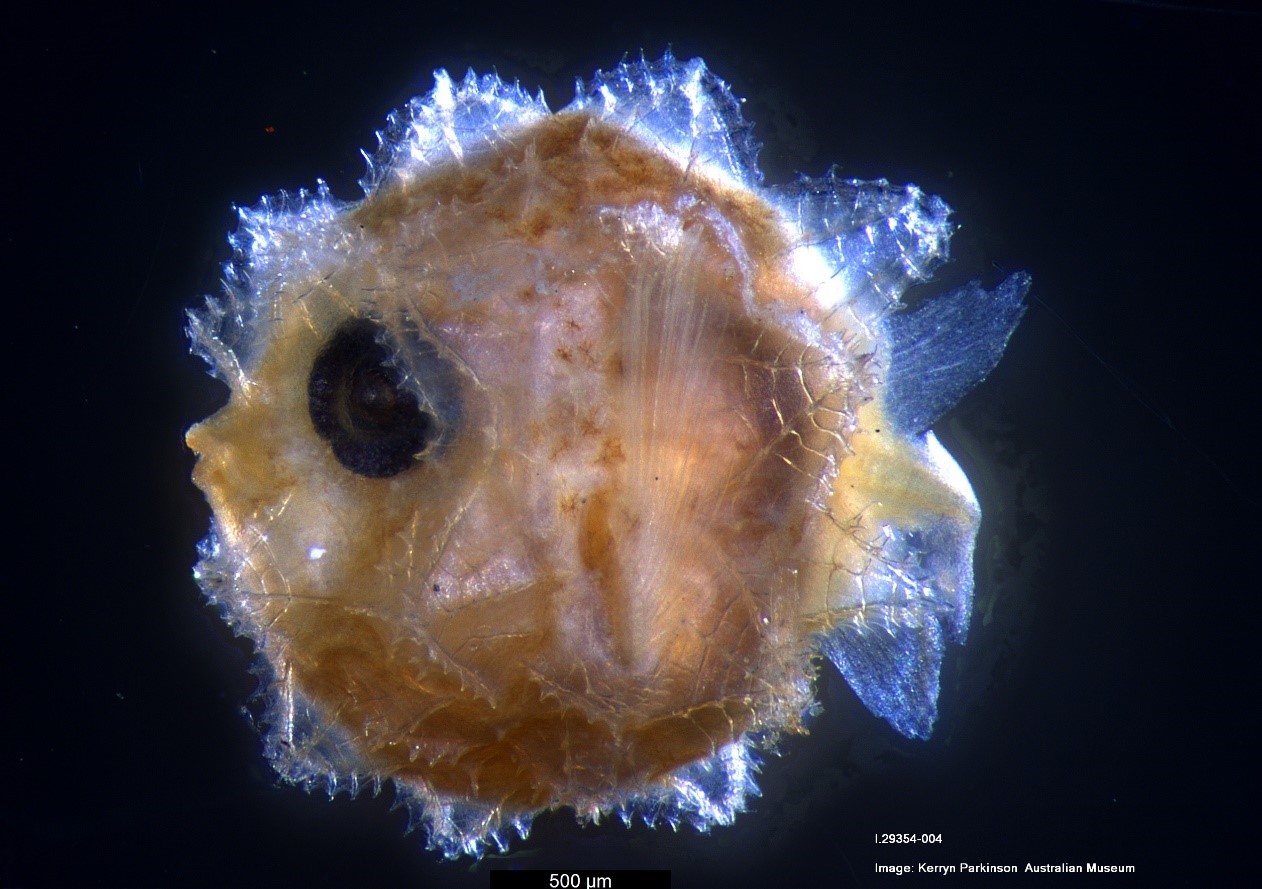Media release
From: Australian MuseumOne of the World’s Largest Fish Develops from a Tiny Larval Mola Sunfish
World First Identification of a larval Mola alexandrini by Australian and New Zealand scientists
22 July 2020, Sydney; Australian and New Zealand scientists have, for the first time, successfully identified the tiny larva of the giant Bump-head Sunfish (Mola alexandrini). Led by sunfish expert, Dr Marianne Nyegaard from the Auckland War Museum in collaboration with Australian Museum scientists, Kerryn Parkinson and Andrew King, the significant discovery was made using the Australian Museum’s (AM) Ichthyology collections and the world-leading AM Genomics Laboratory in Sydney.
The Bump-head Sunfish is one of only three Mola species found in Australian waters, and this breakthrough provides vital information to help scientists understand the entire life cycle of these marine giants and conservation of the unique species.
"This is the first time we have been able to genetically identify a Mola alexandrini larval specimen anywhere in the world,” Dr. Nygaard said.
Collected off the NSW coast in 2017 by the CSIRO RV Investigator, a number of tiny larval Mola specimens came to the attention of Dr. Nyegaard, who was keen to identify the species.
As Dr Nygaard explained, larval fishes often look nothing like their adult form – and for sunfish larvae none of the features used to identify the adult sunfish are visible or relevant in the minute larval specimens - making the identification particularly hard.
“Despite this, using the resources of the Australian Museum’s Genomics Laboratory, we were able to conduct DNA analysis on one of the specimens which was preserved in alcohol.” Nyegaard said.
To minimize damage to the extremely rare larval specimen (approx. 5 mm in length), Kerryn Parkinson from the AM’s Ichthyology division painstakingly removed a single eyeball from the unidentified specimen, and Andrew King, a genomics specialist, conducted the DNA extraction and analysis.
“The DNA sequence from the existing AM specimen was compared to reference data generated by our international collaborators. Differences in the genetic code are analysed statistically to differentiate between the species.
A clear match from the sequence was identified with samples from an adult Bump-head Sunfish (Mola alexandrini),” King explained.
“We will now be able to compare this genetically identified Mola alexandrini larvae with the exceptional collection of Mola larvae sunfish held at the Australian Museum, collected since 1925, along with CSIRO’s Mola larvae collection in Hobart,” Nyegaard added.
Professor Kris Helgen, Chief Scientist and Director of the Australian Museum Research Institute (AMRI), said this research is an important lesson in the value of museum collections.
“Museum collections hold the material from which DNA can be extracted and sequenced. These molecular-level descriptions of the world’s biodiversity provide us with a deep understanding about different species, and their eggs or larvae,” Helgen explained.
“This raw data can give us answers to questions about little known or rare species and provide information about their conservation and management,” Helgen added.
Parkinson said the sunfish (from the family Molidae) has attracted international interest because of their unique shape and large size.
“These beautiful giants of the sea are found worldwide in the open ocean of tropical and temperate seas. The classification of the species from the genus Mola has long been confused, despite the large amount of interest these fishes create. This is mainly due to their rare occurrence to scientists, and difficulties in preserving them for research,” Parkinson said.
To add to the puzzle, Nyegaard said that sunfish hold the record of the highest potential fecundity of any vertebrate - 300 million ova in a 1.5 m long female Ocean Sunfish (Mola mola) - a species which can reach more than 3 metres in length.
“Given sunfish are so incredibly fecund, it is an enigma why their eggs have never been found in the wild, and why sunfish larvae are so few and far between - where are they?”
“A genetic ID of one of these larvae is incredibly important but only one step on the long journey towards describing the early ontogeny of all three Mola species - an endeavour which will require global collaboration. If we want to protect these marine giants we need to understand their whole life history and that includes knowing what the larvae look like and where they occur,” Nyegaard added.
The Australian Museum holds three adult sunfish in its collection and over 14 larval specimens. More info on sunfish here:https://australian.museum/learn/animals/fishes/bump-head-sunfish-mola-alexandrini/
About the Australian Museum
The Australia Museum (AM) was founded in 1827 and is the nation’s first museum. It is internationally recognised as a natural science and culture institution focused on Australia and the Pacific. As custodian of more than 21.9 million objects and specimens, the AM is uniquely positioned to provide a greater understanding of the region through its scientific research, exhibitions and public and education programs. Through the Australian Museum Research Institute (AMRI), the AM also has a leading role in conserving Australia’s biodiversity through understanding the environmental impacts of climate change, potential biosecurity threats and invasive species.
About Australian Museum Research Institute
The research undertaken by the Australian Museum Research Institute informs decision making, policy and global, regional and national efforts to manage biological resources. The Australian Museum Research Institute’s work guides conservation management decisions including management of wild and captive populations of endangered species, protected areas, natural resources such as marine fishing grounds and land restoration.


